Children, particularly those who struggle to learn or those who do not “fit in,” can be the targets of so many mean-spirited jokes and insults that they stop believing in themselves. With nurturing and acceptance, however, they can regain the qualities of self-esteem. The books featured in these reviews show characters of all ages who overcome personal difficulty to recognize their own and others’ personal worth.
Ages 4–8
Janine. Maryann Cocca-Leffler. 2015. Albert Whitman.
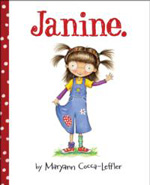 Janine is definitely one of a kind. She sings aloud on the bus, talks to her imaginary friend, reads the dictionary, and remembers random facts. Because she also listens when no one thinks she is, she overhears the “mean girl” extend party invitations. However, the party is only for “cool kids,” and “mean girl” tells Janine, “You are strange! You have to change!” Janine responds, “I do not! I like me!” Janine decides to have her own party and invites everyone, and all the other children want to come. The author’s illustrations are as unique and as playful as Janine herself, and young readers may be inspired by knowing Janine is based on the author’s daughter. The author reads a portion of her book and the real-life Janine talks about navigating life with disabilities here. A related website is a “place of inclusion where EVERYONE is welcome.”
Janine is definitely one of a kind. She sings aloud on the bus, talks to her imaginary friend, reads the dictionary, and remembers random facts. Because she also listens when no one thinks she is, she overhears the “mean girl” extend party invitations. However, the party is only for “cool kids,” and “mean girl” tells Janine, “You are strange! You have to change!” Janine responds, “I do not! I like me!” Janine decides to have her own party and invites everyone, and all the other children want to come. The author’s illustrations are as unique and as playful as Janine herself, and young readers may be inspired by knowing Janine is based on the author’s daughter. The author reads a portion of her book and the real-life Janine talks about navigating life with disabilities here. A related website is a “place of inclusion where EVERYONE is welcome.”
—LTP
Red: A Crayon’s Story. Michael Hall. 2015. HarperCollins/Greenwillow.
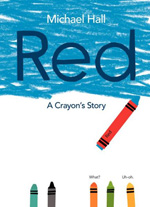 Meet Red, a blue-colored crayon wrapped in a red label. No matter how hard he tries, he just can’t produce the color red. Family and friends make a range of comments about his efforts and offer a variety of suggestions. Despite his perseverance, he continues to fail. When a new crayon friend asks Red to color an ocean for her drawing, Red finally discovers that he is really a blue crayon! Hall’s story contains multiple themes, such as “Be true to yourself despite the labels society tries to wrap around you.” Another theme pertinent to this collection of books is, “Persevere through obstacles that challenge your identity and self-esteem.” This book may be read on many levels; older readers may even uncover a transgender theme. Hall has created colorful crayon-inspired art in keeping with the subject of the book. HarperKids produced an engaging book trailer.
Meet Red, a blue-colored crayon wrapped in a red label. No matter how hard he tries, he just can’t produce the color red. Family and friends make a range of comments about his efforts and offer a variety of suggestions. Despite his perseverance, he continues to fail. When a new crayon friend asks Red to color an ocean for her drawing, Red finally discovers that he is really a blue crayon! Hall’s story contains multiple themes, such as “Be true to yourself despite the labels society tries to wrap around you.” Another theme pertinent to this collection of books is, “Persevere through obstacles that challenge your identity and self-esteem.” This book may be read on many levels; older readers may even uncover a transgender theme. Hall has created colorful crayon-inspired art in keeping with the subject of the book. HarperKids produced an engaging book trailer.
—LDP
Sweep Up the Sun. Helen Frost. 2015. Photographs by Rick Lieder. Candlewick.
 Poet Helen Frost and photographer Rick Lieder have teamed up for another breathtaking union of poetry and nature photos. Their first collaboration, Step Gently Out, encouraged readers to look more closely at the natural world of insects. Sweep Up the Sun invokes readers to spread their wings and soar as they explore their world. Rick Lieder’s stunning close-up photographs of 11 bird species accompany Helen Frost’s poem. The birds are captured in flight and appear in sharp focus against muted backgrounds. A profile of each featured bird is included at the end of the book. Frost’s inspirational poem is a celebration of growth and finding one’s place in the natural world. Her poem can be read as a metaphor for self-discovery, an important step in developing a robust self-esteem. This stunning picture book would make an ideal graduation gift. Helen Frost maintains an extensive website and Rick Lieder’s website presents more of the photographer’s work.
Poet Helen Frost and photographer Rick Lieder have teamed up for another breathtaking union of poetry and nature photos. Their first collaboration, Step Gently Out, encouraged readers to look more closely at the natural world of insects. Sweep Up the Sun invokes readers to spread their wings and soar as they explore their world. Rick Lieder’s stunning close-up photographs of 11 bird species accompany Helen Frost’s poem. The birds are captured in flight and appear in sharp focus against muted backgrounds. A profile of each featured bird is included at the end of the book. Frost’s inspirational poem is a celebration of growth and finding one’s place in the natural world. Her poem can be read as a metaphor for self-discovery, an important step in developing a robust self-esteem. This stunning picture book would make an ideal graduation gift. Helen Frost maintains an extensive website and Rick Lieder’s website presents more of the photographer’s work.
—LDP
Wolfie the Bunny. Ame Dyckman. 2015. Ill. Zachariah OHora. Hatchette/Little, Brown and Company.
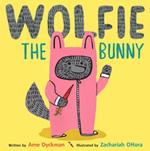 Big brothers and sisters will be able to relate to Dot’s situation: A new baby has joined her family. Dyckman, however, adds a clever and original element to this popular subject of picture books: A baby wolf is left in a basket outside the Bunny family’s door. Dot’s besotted parents blithely ignore her repeated warnings that the new addition to the family is sure to eat them up. While Dot’s parents dote on Wolfie and extol his virtues, Dot stays on guard for trouble. As Wolfie grows, so does his appetite. A trip to the store for more carrots reveals that Dot’s fears are misplaced and gives her the perfect chance to defend her “little” brother. Although the arrival of a new baby can threaten an older sibling’s self-esteem, the event can also provide opportunities to form a new self-identity as a big brother or sister. OHora’s acrylic paintings rendered in a limited and muted color palette add humor and emotional depth to the story. Wolfie the Bunny has earned starred reviews from Booklist, The Horn Book, and School Library Journal. John Schu has created an engaging book trailer.
Big brothers and sisters will be able to relate to Dot’s situation: A new baby has joined her family. Dyckman, however, adds a clever and original element to this popular subject of picture books: A baby wolf is left in a basket outside the Bunny family’s door. Dot’s besotted parents blithely ignore her repeated warnings that the new addition to the family is sure to eat them up. While Dot’s parents dote on Wolfie and extol his virtues, Dot stays on guard for trouble. As Wolfie grows, so does his appetite. A trip to the store for more carrots reveals that Dot’s fears are misplaced and gives her the perfect chance to defend her “little” brother. Although the arrival of a new baby can threaten an older sibling’s self-esteem, the event can also provide opportunities to form a new self-identity as a big brother or sister. OHora’s acrylic paintings rendered in a limited and muted color palette add humor and emotional depth to the story. Wolfie the Bunny has earned starred reviews from Booklist, The Horn Book, and School Library Journal. John Schu has created an engaging book trailer.
—LDP
Ages 9–11
Almost a World Record Breaker (Teddy Mars Book #1). Molly B. Burnham. 2015. Ill. Trevor Spencer. HarperCollins/Katherine Tegen.
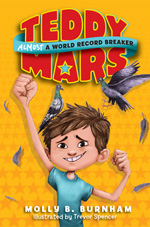 To set a world record, Teddy Mars needs to escape from his family, avoid the Grumpy Pigeon Man, and ditch his 4-year-old brother, The Destructor (who, by the way, sleeps in a clean kitty litter box). After a disastrous birthday, Teddy moves to a tent in the backyard, which gets Teddy away from The Destructor, but it also prompts Grumpy Pigeon Man to hire him to help care for his 57 pigeons. With the help of his two best friends, Teddy unsuccessfully attempts to set a world record for raking the largest leaf pile, stretching the most rubber bands on his face, and getting the most pigeons to land on him. When Teddy is at his lowest, he discovers he has always had his family’s support. Actual (read: bizarre) world records are artfully inserted in the narrative, and the font size, ample white space, and illustrations make this a perfect read for the younger middle-grade audience. There’s a lot to love here: a quirky family, an eccentric next door neighbor, best friends, and a dream come true. Students who have discovered the Guinness Book of World Records will relate to Teddy’s obsession.
To set a world record, Teddy Mars needs to escape from his family, avoid the Grumpy Pigeon Man, and ditch his 4-year-old brother, The Destructor (who, by the way, sleeps in a clean kitty litter box). After a disastrous birthday, Teddy moves to a tent in the backyard, which gets Teddy away from The Destructor, but it also prompts Grumpy Pigeon Man to hire him to help care for his 57 pigeons. With the help of his two best friends, Teddy unsuccessfully attempts to set a world record for raking the largest leaf pile, stretching the most rubber bands on his face, and getting the most pigeons to land on him. When Teddy is at his lowest, he discovers he has always had his family’s support. Actual (read: bizarre) world records are artfully inserted in the narrative, and the font size, ample white space, and illustrations make this a perfect read for the younger middle-grade audience. There’s a lot to love here: a quirky family, an eccentric next door neighbor, best friends, and a dream come true. Students who have discovered the Guinness Book of World Records will relate to Teddy’s obsession.
—LTP
Blue Birds. Caroline Starr Rose. 2015. G.P. Putnam’s Sons/Penguin Group.
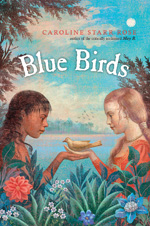 Set in 1587, this novel in verse imagines the lives of Alis, the only young girl in what became known as the Lost Colony of Roanoke, and Kimi, a young girl of the Roanoke. The girls’ initial mistrust is palpable. Alis’s group finds the settlement deserted when they arrive, and her beloved uncle is missing. Kimi’s father was beheaded by those early settlers who brought the disease that killed her sister. Through the girls’ distinct voices, Rose masterfully conveys a sense of urgency as tensions between the two groups escalate. Yet the girls slowly overcome their fear to cross cultural boundaries, share the beauty and wonder of the land, and develop a deep and abiding friendship. In an author’s note, Rose explains that she became intrigued by the mystery of the Lost Colony while teaching fifth-grade social studies, and she fleshes out fact and fiction. This would be an excellent addition to classroom and school libraries and would be a powerful read-aloud or supplemental reading for middle-grade students studying the Lost Colony.
Set in 1587, this novel in verse imagines the lives of Alis, the only young girl in what became known as the Lost Colony of Roanoke, and Kimi, a young girl of the Roanoke. The girls’ initial mistrust is palpable. Alis’s group finds the settlement deserted when they arrive, and her beloved uncle is missing. Kimi’s father was beheaded by those early settlers who brought the disease that killed her sister. Through the girls’ distinct voices, Rose masterfully conveys a sense of urgency as tensions between the two groups escalate. Yet the girls slowly overcome their fear to cross cultural boundaries, share the beauty and wonder of the land, and develop a deep and abiding friendship. In an author’s note, Rose explains that she became intrigued by the mystery of the Lost Colony while teaching fifth-grade social studies, and she fleshes out fact and fiction. This would be an excellent addition to classroom and school libraries and would be a powerful read-aloud or supplemental reading for middle-grade students studying the Lost Colony.
—LTP
Fish in a Tree. Lynda Mullaly Hunt. 2015. Penguin/Nancy Paulsen.
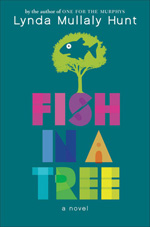 A talented artist who creates movies in her mind, sixth grader Ally has mastered the art of disruption to mask the fact that she cannot read. Her self-esteem has been shattered because of the many times she has been told she is dumb. Ally has been in seven schools in seven years, and her military father is currently deployed, but her Sketchbook of Impossible Things helps her cope. Enter long-term sub Mr. Daniels, who identifies her dyslexia, gradually gains her trust, and teaches her to read. Ally forms a friendship with outspoken Keisha and scientific Albert, who don’t seem to care what others think about them, and she finds support and acceptance at home from her mother and adored older brother (who, we infer, also has dyslexia). The tropes of a mean-girl nemesis and her sycophant friend, a trio of misfit friends, and an unorthodox teacher along with the use of metaphors to affirm difference could seem heavy handed, yet Hunt has created a feel-good read about a young girl who discovers the many guises of courage. Reminiscent of Bluefish (Schmatz, 2013), this is a book that begs to be read aloud to middle-grade students.
A talented artist who creates movies in her mind, sixth grader Ally has mastered the art of disruption to mask the fact that she cannot read. Her self-esteem has been shattered because of the many times she has been told she is dumb. Ally has been in seven schools in seven years, and her military father is currently deployed, but her Sketchbook of Impossible Things helps her cope. Enter long-term sub Mr. Daniels, who identifies her dyslexia, gradually gains her trust, and teaches her to read. Ally forms a friendship with outspoken Keisha and scientific Albert, who don’t seem to care what others think about them, and she finds support and acceptance at home from her mother and adored older brother (who, we infer, also has dyslexia). The tropes of a mean-girl nemesis and her sycophant friend, a trio of misfit friends, and an unorthodox teacher along with the use of metaphors to affirm difference could seem heavy handed, yet Hunt has created a feel-good read about a young girl who discovers the many guises of courage. Reminiscent of Bluefish (Schmatz, 2013), this is a book that begs to be read aloud to middle-grade students.
—LTP
Ages 12–14
Mosquitoland. David Arnold. 2015. Viking/Penguin Group.
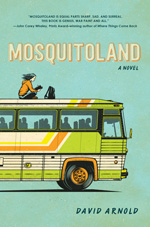 Mim Malone has seen her fair share of troubles, including her parents’ divorce, her dad’s remarriage, and a traumatic move from Ohio to Mississippi. In fact, the first chapter of the novel is contained within this single line of text: “I AM MARY Iris Malone, and I am not okay.” When Mim overhears her dad and stepmom discussing her mother’s secret disease, she impulsively decides to hop a Greyhound bus to Cleveland to find her mother. Mim encounters a variety of friends and foes along the way. This novel is brimming with issues, such as the shifting line between sanity and mental illness. Mim is a quirky character with attitude and a strong voice. Her observations on the people and situations she encounters along her journey of self-discovery are peppered with scathing sarcasm and witty humor. Ultimately, Mim overcomes a host of personal difficulties and learns important lessons about loyalty and love. Most notably, she realizes the complexity of being human: Heroes have faults, and villains have virtues. David Arnold’s writing is masterful and eloquent; this is a book to reread and savor. The audiobook, read by Phoebe Strole, is particularly captivating. Mosquitoland has received starred reviews from Booklist, Kirkus Reviews, and Publishers Weekly. The book also made Kids’ Indie Next List “Top Ten” Pick for Spring 2015. Penguin Teen created a dramatic trailer featuring an original song written and produced by the author.
Mim Malone has seen her fair share of troubles, including her parents’ divorce, her dad’s remarriage, and a traumatic move from Ohio to Mississippi. In fact, the first chapter of the novel is contained within this single line of text: “I AM MARY Iris Malone, and I am not okay.” When Mim overhears her dad and stepmom discussing her mother’s secret disease, she impulsively decides to hop a Greyhound bus to Cleveland to find her mother. Mim encounters a variety of friends and foes along the way. This novel is brimming with issues, such as the shifting line between sanity and mental illness. Mim is a quirky character with attitude and a strong voice. Her observations on the people and situations she encounters along her journey of self-discovery are peppered with scathing sarcasm and witty humor. Ultimately, Mim overcomes a host of personal difficulties and learns important lessons about loyalty and love. Most notably, she realizes the complexity of being human: Heroes have faults, and villains have virtues. David Arnold’s writing is masterful and eloquent; this is a book to reread and savor. The audiobook, read by Phoebe Strole, is particularly captivating. Mosquitoland has received starred reviews from Booklist, Kirkus Reviews, and Publishers Weekly. The book also made Kids’ Indie Next List “Top Ten” Pick for Spring 2015. Penguin Teen created a dramatic trailer featuring an original song written and produced by the author.
—LDP
Under a Painted Sky. Stacey Lee. 2015. G.P. Putnam’s Sons/Penguin Group.
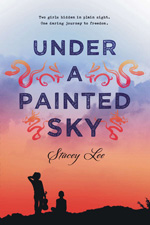 The year is 1849, the place is a small town in Missouri. Samantha, a 15-year-old Chinese girl, commits a crime in self-defense after the tragic loss of her father. Annamae, a young slave, helps her in the aftermath of the crime. Disguising themselves as boys, they band together in their search for freedom from imprisonment and enslavement. They find themselves on the Oregon Trail, where they are befriended by a trio of cowboys who become their allies. Lee’s characters are fully developed and complicated. The girls form a deep bond as they struggle to maintain their disguises and survive amid harsh and dangerous conditions. This work of historical fiction is a unique story of the Oregon Trail, one full of adventure and resourcefulness. Both “Sammy” and “Andy” encounter discrimination, but it is their mutual support and belief in one another that helps each to discover their own self-worth. At the heart of the book is a friendship between two characters who keep each other’s hope alive in the face of grief and despair. A guide for educators can be found on the author’s website.
The year is 1849, the place is a small town in Missouri. Samantha, a 15-year-old Chinese girl, commits a crime in self-defense after the tragic loss of her father. Annamae, a young slave, helps her in the aftermath of the crime. Disguising themselves as boys, they band together in their search for freedom from imprisonment and enslavement. They find themselves on the Oregon Trail, where they are befriended by a trio of cowboys who become their allies. Lee’s characters are fully developed and complicated. The girls form a deep bond as they struggle to maintain their disguises and survive amid harsh and dangerous conditions. This work of historical fiction is a unique story of the Oregon Trail, one full of adventure and resourcefulness. Both “Sammy” and “Andy” encounter discrimination, but it is their mutual support and belief in one another that helps each to discover their own self-worth. At the heart of the book is a friendship between two characters who keep each other’s hope alive in the face of grief and despair. A guide for educators can be found on the author’s website.
—LDP
Ages 15+
Bone Gap. Laura Ruby. 2015. HarperCollins/Balzer + Bray.
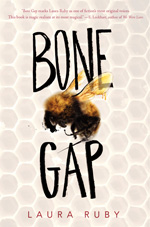 Welcome to Bone Gap, a place with gaps between realms. A unique cast of characters inhabit this place of mystery: the O’Sullivan brothers, Sean and Finn; Roza, a young woman who appears in their barn one day; and Petey, the local beekeeper’s daughter who befriends Finn. All of the characters are complex, and their experiences inform and affect each other’s storylines. When Roza goes missing, no one believes Finn’s account of her abduction, one that suspiciously lacks a description of the captor. The townspeople’s distrust of Finn undermines his ability to believe in himself and the events of the day that Roza disappeared. It is Petey who solves the mystery of the missing pieces of Finn’s story. Petey’s belief in Finn gives him the confidence to embark on a hero quest and travel through a magical gap between worlds to rescue Roza. But Roza is her own hero, one whose rebellion against society’s fascination with beauty eventually leads to her freedom. Laura Ruby has written a genre-bending story; fairy tale and mythological elements are interwoven with elements of realism in this wholly original and compelling read. Bone Gap has garnered starred reviews from Booklist, Kirkus Reviews, Publishers Weekly, and Voya. Julie Bartel interviewed the author on The Hub, YALSA’s literature blog.
Welcome to Bone Gap, a place with gaps between realms. A unique cast of characters inhabit this place of mystery: the O’Sullivan brothers, Sean and Finn; Roza, a young woman who appears in their barn one day; and Petey, the local beekeeper’s daughter who befriends Finn. All of the characters are complex, and their experiences inform and affect each other’s storylines. When Roza goes missing, no one believes Finn’s account of her abduction, one that suspiciously lacks a description of the captor. The townspeople’s distrust of Finn undermines his ability to believe in himself and the events of the day that Roza disappeared. It is Petey who solves the mystery of the missing pieces of Finn’s story. Petey’s belief in Finn gives him the confidence to embark on a hero quest and travel through a magical gap between worlds to rescue Roza. But Roza is her own hero, one whose rebellion against society’s fascination with beauty eventually leads to her freedom. Laura Ruby has written a genre-bending story; fairy tale and mythological elements are interwoven with elements of realism in this wholly original and compelling read. Bone Gap has garnered starred reviews from Booklist, Kirkus Reviews, Publishers Weekly, and Voya. Julie Bartel interviewed the author on The Hub, YALSA’s literature blog.
—LDP
Hold Me Closer: The Tiny Cooper Story. David Levithan. 2015. Dutton Books for Young Readers/Penguin.
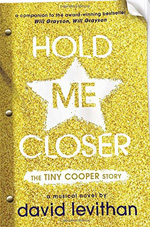 For anyone and everyone who fell in love with Tiny Cooper in Green and Levithan’s (2010) Will Grayson, Will Grayson, Tiny is back and unabashedly telling his larger-than-life story; there is no lack of self-esteem here. The autobiographical musical Tiny wrote and staged in Will Grayson, Will Grayson is presented as a two-act script complete with dialogue and musical numbers, and Tiny is large and in charge through his staging directions, solos, and monologues. Act I tells of Tiny’s childhood and coming out through musical numbers including “Oh! What a Big Gay Baby,” “Ballad of the Lesbian Babysitter,” and “Stating the Obvious.” Act II opens with the “Parade of the Ex-Boyfriends” and tracks the 18 times Tiny falls in and out of love and what he learns about love along the way. Although there is currently no sheet music, Levithan proposed the idea of crowd-sourcing the musical. This musical-novel or novel-musical is a razzle-dazzle, laugh-out-loud, break-your-heart exploration of the quest for true romantic love.
For anyone and everyone who fell in love with Tiny Cooper in Green and Levithan’s (2010) Will Grayson, Will Grayson, Tiny is back and unabashedly telling his larger-than-life story; there is no lack of self-esteem here. The autobiographical musical Tiny wrote and staged in Will Grayson, Will Grayson is presented as a two-act script complete with dialogue and musical numbers, and Tiny is large and in charge through his staging directions, solos, and monologues. Act I tells of Tiny’s childhood and coming out through musical numbers including “Oh! What a Big Gay Baby,” “Ballad of the Lesbian Babysitter,” and “Stating the Obvious.” Act II opens with the “Parade of the Ex-Boyfriends” and tracks the 18 times Tiny falls in and out of love and what he learns about love along the way. Although there is currently no sheet music, Levithan proposed the idea of crowd-sourcing the musical. This musical-novel or novel-musical is a razzle-dazzle, laugh-out-loud, break-your-heart exploration of the quest for true romantic love.
—LTP
The Truth Commission. Susan Juby. 2015. Viking Books for Young Readers/Penguin.
 The Truth Commission is Normandy Pale’s creative nonfiction Grade 11 Spring Special Project at Green Pastures Academy of Art and Applied Design. Although Normandy describes herself as “deadly normal,” her older sister is famous for her fantasy graphic novels that parody their family and have led to Norm’s “damaged self-esteem.” Norm and her best friends Dusk and Neil form the Truth Commission to uncover the truths “lying around, half exposed in the street, like drunken cheerleaders trying to speak.” Norm is an unwilling participant, and her unease increases when a student suggests she should seek the truth a little closer to home. This leads Norm to delve into the truths about her brilliant older sister and her dysfunctional family. Norm’s voice is witty, snarky, and intelligent as she vacillates between self-assurance and self-doubt, and the dialogue and dynamics between the three friends is spot on. Readers will root for Normandy as she writes her own story and discovers her own truth.
The Truth Commission is Normandy Pale’s creative nonfiction Grade 11 Spring Special Project at Green Pastures Academy of Art and Applied Design. Although Normandy describes herself as “deadly normal,” her older sister is famous for her fantasy graphic novels that parody their family and have led to Norm’s “damaged self-esteem.” Norm and her best friends Dusk and Neil form the Truth Commission to uncover the truths “lying around, half exposed in the street, like drunken cheerleaders trying to speak.” Norm is an unwilling participant, and her unease increases when a student suggests she should seek the truth a little closer to home. This leads Norm to delve into the truths about her brilliant older sister and her dysfunctional family. Norm’s voice is witty, snarky, and intelligent as she vacillates between self-assurance and self-doubt, and the dialogue and dynamics between the three friends is spot on. Readers will root for Normandy as she writes her own story and discovers her own truth.
—LTP
Linda T. Parsons is an associate professor in the Department of Teaching and Learning on the Marion Campus of The Ohio State University, where she specializes in middle childhood literacy and young adult literature. Lisa D. Patrick is a literacy coach trainer at The Ohio State University’s Literacy Collaborative, where she specializes in children’s literature and early literacy.
The review contributions are provided by members of the International Literacy Association’s Children’s Literature and Reading Special Interest Group.